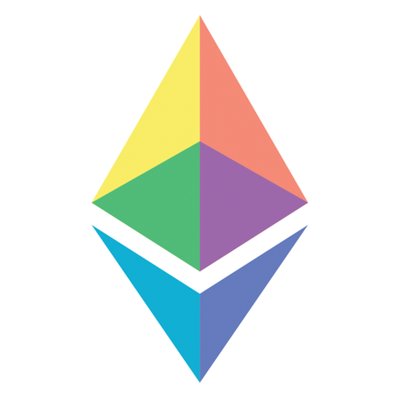The Ethereum blockchain is evolving towards modularity
The Concept of Modular Blockchain
Modular blockchain focuses on handling a limited number of responsibilities while outsourcing the rest to one or more independent layers. Modular blockchains can be used to handle the following individual tasks or combinations of tasks:
Execution: Supporting the execution of transactions and enabling the deployment and interaction with smart contracts.
Data Availability: Ensuring the availability of transaction data.
Consensus: Permitting the content and order of transactions.
Settlement: Used for completing transactions, resolving disputes, verifying proofs, and bridging between different execution layers.
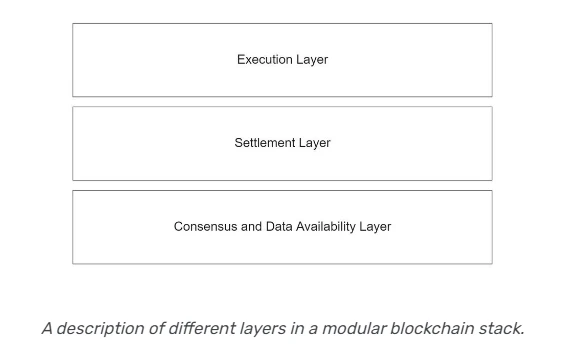
Modular chains typically perform two or more interdependent functions. For example, the data availability layer must reach consensus on data ordering; otherwise, it would be impossible to know which data represents the correct version of the history.
Advantages of Modular Blockchain Design
Scalability: Using modularity in blockchain can increase scale without introducing harmful trust assumptions.
Easier to Launch New Blockchains: By leveraging modular design, new blockchains can be launched more quickly without having to ensure every aspect of the architecture is correct.
Flexibility: Purpose-built modular chains provide more options for trade-offs and design implementations. For instance, a modular blockchain system may include chains focused on security and data availability, while others focus on execution.
Disadvantages of Modular Blockchain Design
Security: Unlike monolithic chains, modular blockchains cannot guarantee their own security quality. If the security layer used for handling consensus and data availability is ineffective, the modular blockchain faces a risk of failure.
Complexity: Implementing a modular blockchain design introduces new complexities. For example, Ethereum's data sharding plan relies on data availability sampling to ensure that nodes on a shard do not conceal data. Similarly, the execution layer must create certain complex mechanisms, such as fraud proofs and validity proofs, to allow the security layer to guarantee the validity of off-chain state transitions.
Token Value: Due to limited applications, the native tokens of some modular blockchains may struggle to absorb value. For example, utility tokens focused solely on consensus and data availability layers have fewer use cases compared to execution layers, making it potentially more difficult to attract participants to such networks.
Ethereum's Modular Forms: Sharding and Rollup
Like first-generation blockchains such as Bitcoin, Ethereum was initially designed as a monolithic blockchain. However, to enhance network performance, improve scalability, and sustainability, the Ethereum network is currently transitioning to a modular framework.
Sharding is the process of dividing a system (such as a database) into multiple parts to operate. By distributing functionality across multiple components, the system can achieve greater output and efficiency. In a blockchain network, sharding divides the blockchain into multiple sub-chains, with each sub-chain handling different parts of network activity.
In Ethereum's sharding design, 64 shard chains will run in parallel. Shards can process transactions in parallel (execution shards) or be used to store different parts of blockchain data (data shards). With data sharding, Ethereum nodes will only store the data published on their shard chains—this contrasts with the current structure, which requires all nodes to store the same data.
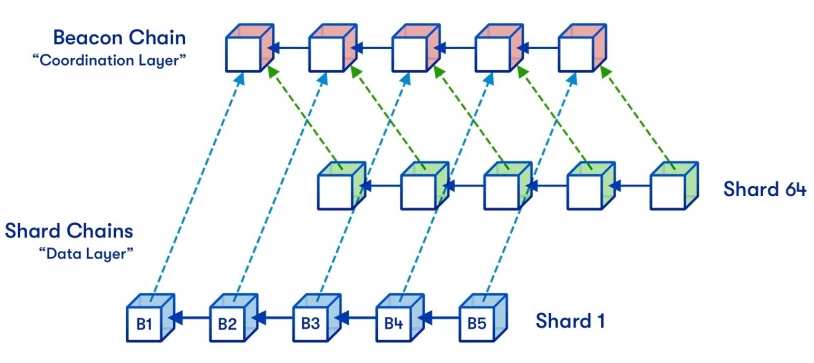
The relationship between Ethereum's beacon chain and shard chains
Sharding is a modular form where different components (shard chains) handle different responsibilities. In data sharding, shard chains store different parts of Ethereum data, while execution shards allow each shard chain to process its own set of transactions, thereby increasing data throughput and reducing processing time.
Some developers have adopted a rollup-centric approach to scale Ethereum. Unlike pure off-chain scaling solutions (such as sidechains), rollups are tightly integrated with the main chain. While retaining settlement, consensus, and data availability, the Ethereum blockchain outsources computation to rollups. As Ethereum serves as the base layer for L2 rollups, rollups can actively optimize execution through faster block times and larger blocks without compromising decentralization or security.
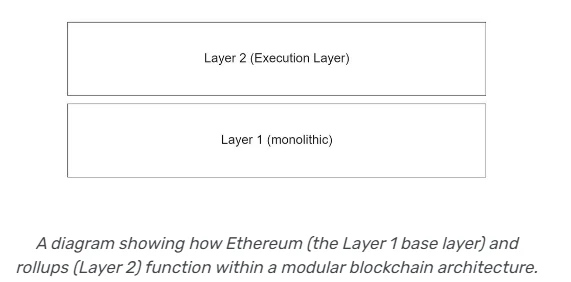
The functions of Ethereum (L1 base layer) and rollups (L2) in modular blockchain architecture
Development Progress of Ethereum's Modular Technology Stack
The development progress of Ethereum's modular technology stack is as follows:
Monolithic Blockchain: Represents Ethereum L1 or the main chain, which is itself a monolithic blockchain.
Rollup: Acts as an L2 solution for the execution layer, such as Arbitrum and Optimism, moving the execution layer off Ethereum L1, publishing state roots and rollup data back to Ethereum L1.
Modular Rollup: Rollups with modular data availability.
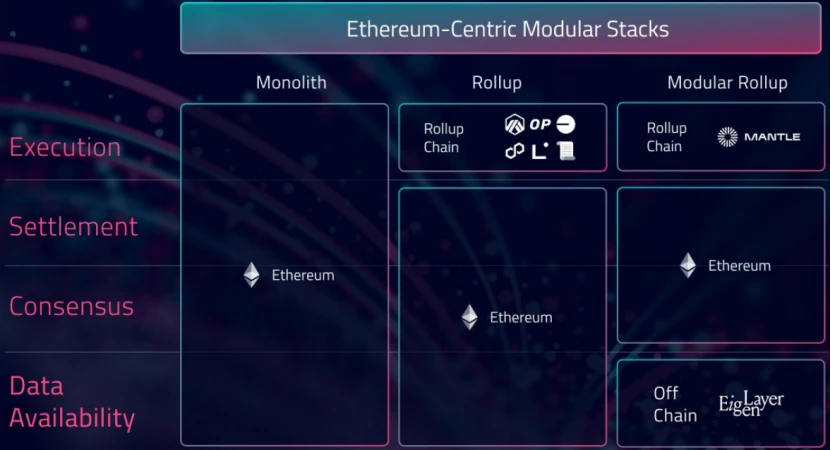
Ethereum's modular L2 technology stack can provide scalability while maintaining a high level of security and decentralization. This powerful combination lays the foundation for a more efficient and sustainable blockchain ecosystem for Ethereum.
Monolithic Blockchain
The monolithic blockchain is Ethereum's original operating form, handling everything without the need for rollups or data sharding. This monolithic architecture has the highest security but comes at a high cost and limited scalability. As a result, the transaction speed of Ethereum's mainnet is relatively slow, with an average TPS of only 15–20. Currently, Ethereum is gradually transitioning to a modular blockchain, primarily through the adoption of rollup-centric computation and data sharding strategies.
Rollup
Rollups are the earliest technological breakthrough in modular blockchains, providing a separate layer for execution that extends Ethereum's monolithic architecture. Rollups can securely abstract the execution layer of the blockchain to a sequencer, which uses powerful computers to package and execute multiple transactions before periodically sending compressed data back to the Ethereum mainnet for verification. By shifting this computation process off-chain, rollups can increase TPS by 20–50 times.
In the current scenario, rollups serve as the execution layer, handling transactions while outsourcing settlement, consensus, and data availability. For example, optimistic rollups using the Optimistic Virtual Machine and ZK rollups running zk EVM. These rollups execute smart contracts and handle transactions but still rely on Ethereum for the following operations:
Settlement: All rollup transactions are completed on Ethereum. Users of optimistic rollups must wait for the challenge period to pass or for transactions to be deemed valid after anti-fraud calculations. ZK rollup users must wait until the validity is proven.
Consensus and Data Availability: Rollups publish transaction data to the Ethereum mainnet in the form of CallData, allowing anyone to execute rollup transactions and reconstruct their state when needed. Before finality, optimistic rollups require a significant amount of block space and a challenge period of 7–14 days. ZK rollups retain data that can be verified for 30 days, providing instant finality but requiring substantial processing power to create proofs.
With Ethereum serving as the base layer for rollups, rollups can allow for faster block times and larger blocks without compromising decentralization or security. Rollups can be seen as the beginning of a new era for Ethereum. Recently, the total transactions of Arbitrum and Optimism have surpassed those of Ethereum, reflecting the modular trend of Ethereum.
Modular Rollup
Newer modular rollups move the data availability layer off Ethereum. For example, Mantle still relies on Ethereum for settlement and consensus but utilizes Mantle DA as the data availability layer. Mantle DA sorts data and provides data proofs without executing transactions; executing transactions is effectively outsourced to Mantle's execution layer.
Previously, Ethereum was the only data availability solution for rollups, leading to cost challenges. Data availability is the largest cost source for most rollups, especially storing transaction data on Ethereum, which can account for up to 70% of fees. Moreover, this cost is variable and increases proportionally with usage, gradually becoming a significant barrier as more users join. So far, only large rollups with substantial resources can accommodate larger user bases.
Fortunately, Ethereum is changing, and new modular solutions in the form of data availability layers are emerging to reduce the costs of transaction data submission. Major examples of data availability layers include EigenDA, Celestia, and Avail, all of which aim to address data availability issues and provide potential solutions to the limitations of rollups.
The Future of Modularity
Over the past decade, the blockchain space has often fallen into a vicious cycle when addressing scalability challenges—constantly creating new L1 blockchains due to Ethereum's high costs and limitations. However, the high fees of Ethereum are not an insurmountable bug.
In a world where L2 solutions are gradually becoming the norm for mass adoption, modular blockchains are transforming the architecture of blockchain by delineating execution, settlement, consensus, and data availability layers. As monolithic blockchains become constrained by scalability, the potential of modular architecture will be unleashed.
As data availability layers evolve and compete, the entry barriers and obstacles for new rollups will be significantly lowered. In the near future, due to reduced data availability costs and further enhancements in modular functionality, applications on OP or ZK stacks are likely to flourish.





